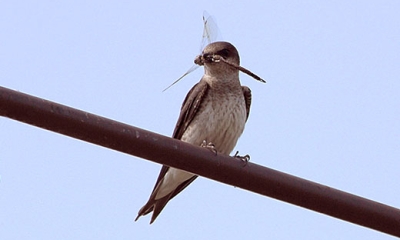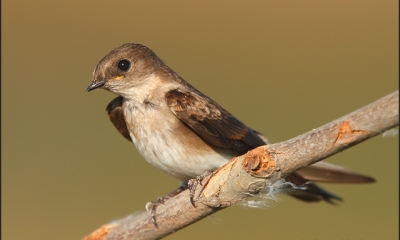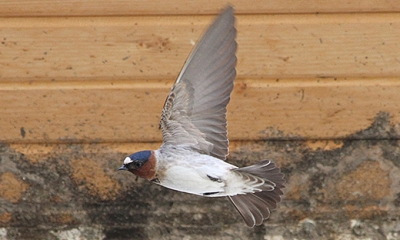
Swallows and Martins
Oregon has one martin and six swallows.

Types of Swallows and Martins

All have cause to marvel at the sight of a gorgeous male Purple martin. Adult males are entirely glossy bluish-purple, although they may look black in poor light. Females and yearling males are grayish below and darker above with a paler forehead and nape.
The world's largest swallow, martins are uncommon in Oregon. They nest both solitarily and colonially in nest boxes specially put up for them, in crevices in human-made structures, and in cavities in snags and pilings.
They are an uncommon local summer resident, principally inhabiting the Coast Range and Willamette Valley. They are also locally common at Fern Ridge Reservoir, in Lane County and at some coastal estuaries and numerous colonies along the Columbia River from Hood River to Astoria.
Purple martins are an Oregon Conservation Strategy Species in the Coast Range, Klamath Mountains, West Cascades, and Willamette Valley ecoregions.
Hear the call and song of the Purple martin
Photo by Kathy Munsel, ODFW

A colorful harbinger of spring, the hardy Tree swallow arrives from the south during February each year. It is a highly social species that is usually observed in large flocks often with Violet-green and other swallow species.
It is not colonial but several pairs may nest together if available cavities are clustered. The Tree swallow is a bird of open places near water and is seldom seen in residential neighborhoods or built-up urban areas. It is the only swallow that eats berries and small seeds as well as insects.
In Oregon, it is a locally abundant summer resident and breeding bird throughout the state, typically near water with adjacent snags. Distribution and population levels are mainly limited by the availability of suitable nesting cavities.
Hear the song of the Tree swallow
Photo by Charlotte Ganscopp

Dashing and darting about, flashing its bright white underparts, the Violet-green Swallow is one of the characteristic birds of summer. Unlike the Tree Swallow it commonly nests in niches and cavities on urban buildings and readily uses nesting boxes in residential areas. Its soft twittery call notes are a familiar pre-dawn sound as they fly about overhead.
The Violet-green swallow is a very early spring migrant concentrating about streams and wetlands where emerging insects can be found until warmer weather allows them to move into more upland areas. It is a common to abundant summer resident and breeding species throughout most of Oregon, though uncommon in the Klamath Basin.
Hear the call and song of the Violet-green swallow
Photo by David W. Leer

Rich, warm, unpatterned brown above and dull white below with a dusky throat and breast, the Rough-winged swallow is inconspicuous and often overlooked when flying with other, more brightly colored swallows. It is often confused with the similarly plumaged Bank and immature Tree swallows. It is most often observed flying low over rivers and lakes, rarely high overhead.
It is a locally common summer resident statewide, most abundant at low to moderate elevations, usually near water. It usually nests singly, but sometimes in small loose colonies, rarely more than three pairs. Distribution is limited in many areas by lack of suitable nest sites. Nests are usually located along waterways, road-cuts, or quarries with nearby open areas for foraging.
Hear the call and song of the Norther rough-winged swallow
Photo by Julio Mulero, Flickr

This colonial-nesting swallow places its nest at the end of a burrow dug into a soft cliff or bank. The nesting cliff often appears riddled with holes, but not all burrows are used for nesting. A highly social species, the Bank swallow is usually observed in flocks of its own or with other swallow species. It has dark wings and tail that contrast with the paler brown back. The underparts are whitish except for a distinct brown breastband.
It is a generally uncommon, but locally common to abundant summer resident at mid- to low elevations east of the Cascades. Numerous colonies contain 10-100 pairs; a few exceed 500 pairs. A few pairs occasionally nest west of the Cascades, but most colonies are unstable and short lived.
Hear the call of the Bank swallow
Photo by Kathy Munsel, ODFW

This chunky swallow is readily recognized by its square tail and orangish rump patch. It nests colonially and has taken to human-made structures so well that it has greatly expanded its range into many areas otherwise not suitable for it. It does not do well in urban settings, however, and quickly disappears when areas become densely settled. The unique gourd-shaped mud nest is often usurped by other species for nesting and is often used for protective roosting sites by rosy-finches and other wintering species.
It is a locally common to abundant breeding bird near water throughout most of Oregon. Its largest colonies occur on cliff faces along waterways east of the Cascades.
Hear the call and song of the Cliff swallow
Photo by Kathy Munsel, ODFW

With its long, forked tail and long wings, it is the most graceful of all land birds and reminds one of the smaller terns not only in shape but in behavior. The Barn swallow has taken so completely to nesting on human-made structures that one forgets they were once restricted to caves and rock crevices. Almost every farm in the state has a pair or two nesting in an outbuilding, and very few bridges do not have a pair or two. It is the best known of the swallows.
It is a fairly common to locally abundant summer resident and breeding bird throughout Oregon and is restricted primarily to human made structures, especially farm outbuildings, bridges and homes.
Hear the call and song of the Barn swallow
Photo from ODFW

